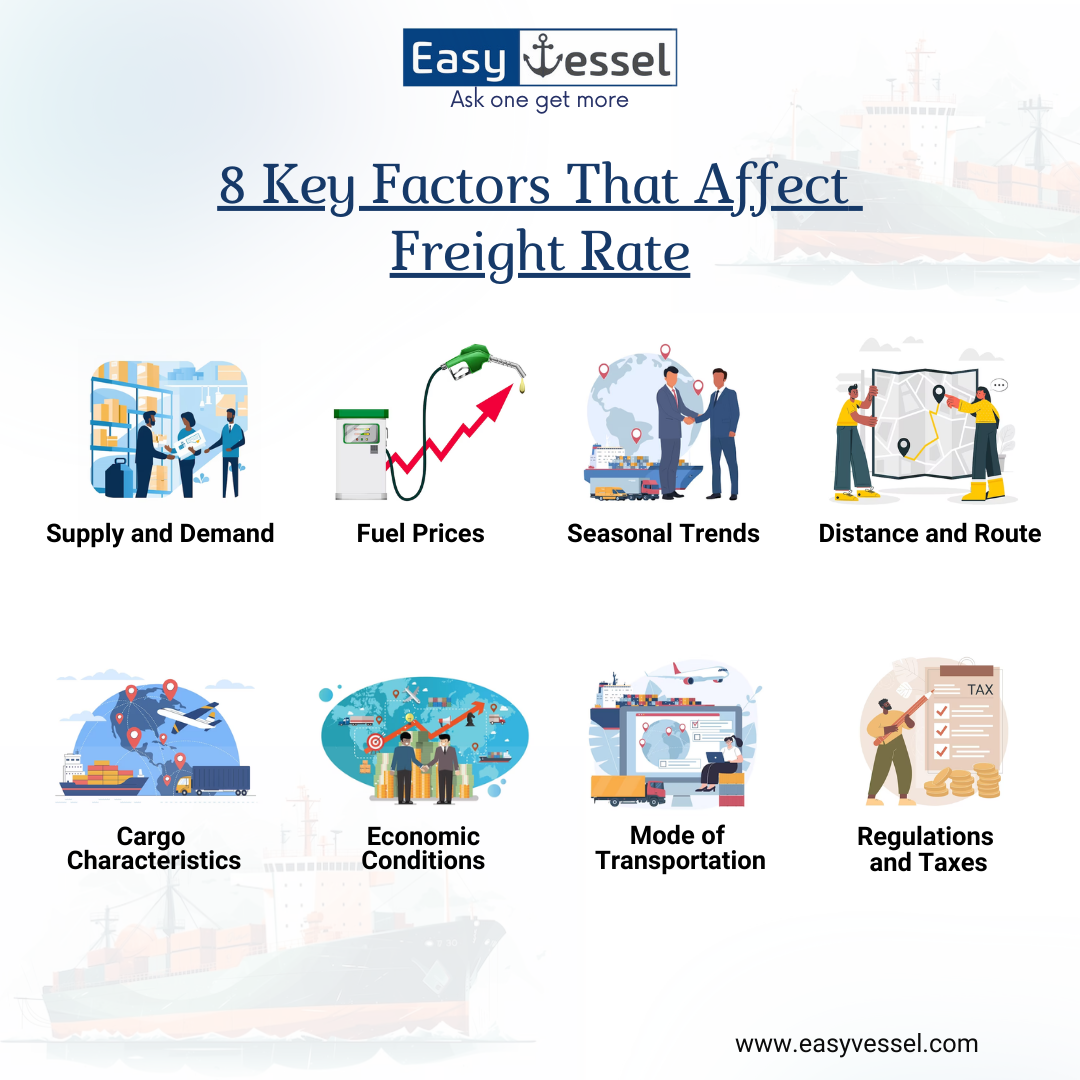- The Indian logistics industry’s size is approximately $250 billion, and it is expected to grow to $380 billion by 2025.
- One of the key drivers behind this growth is the process of moving goods from one place to another, known as freight shipping.
- In recent times, freight shipping rates have been experiencing constant changes.
- To optimize your shipping strategy and avoid inefficiencies in your business.
- It’s crucial to understand the factors influencing these freight rates.
- In this article, we will delve into the significant factors that impact freight rates.
Freight Rate Meaning:
- A freight rate is the price or cost you pay to transport goods from one place to another.
- It’s like a fee you give to the company that moves your stuff, whether it’s by truck, ship, train, or plane.
- This rate can vary based on factors like the type of goods, distance, and how quickly you need them delivered.
- The average freight rates in India vary depending on the mode of transportation, the distance traveled, the type of cargo, and other factors.
- However, according to a report by CRISIL, the average railway freight rate in India in the financial year 2022 was 1.6 Indian rupees per metric ton kilometer.
- This means that it costs an average of 1.6 Indian rupees to transport one metric ton of cargo one kilometer by rail.
- For road transport, the average freight rate is around 3.6 Indian rupees per metric ton kilometer.
- Air transport is the most expensive mode of transportation, with freight rates of around 18 Indian rupees per metric ton kilometer.
8 Key Factors that Affect Freight Rate:
Here are the main 8 key factors that affected freight rates:
- Supply and Demand
- Fuel Prices (particularly diesel)
- Seasonal Trends
- Distance and Route
- Cargo Characteristics
- Economic Conditions
- Mode of Transportation
- Regulations and Taxes
Supply and Demand:
- This is like a seesaw. When there are lots of goods to be shipped but not enough trucks or ships, prices (rates) go up.
- But when there are more trucks or ships than things to ship, prices go down.
- Faster deliveries come at a higher cost. Plan efficient routes and consider same-day or overnight options when necessary.
- Third-party logistics providers can help optimize deliveries.
- Bigger and heavier shipments cost more to transport because they require more space and effort.
- To save on costs, use lightweight packaging and look for carriers with good reviews.
Fuel Prices (particularly diesel):
- Fuel prices affect freight rates.
- When fuel prices rise, so do shipping costs.
- Establish a good relationship with your freight provider to mitigate these fluctuations.
Seasonal Trends:
- Think about how stores have sales during holidays.
- In shipping, when there’s a time of year when lots of things need to be shipped (like Christmas gifts), prices go up during that season.
- High demand during peak seasons can drive up costs.
- Maintain a good partnership with your freight provider to manage your budget during market fluctuations.
Distance and Route:
- Longer distances mean higher shipping costs.
- Try to consolidate deliveries to specific areas and add more fulfillment centers where needed to save on transportation expenses.
Cargo Characteristics:
- Not all things are easy to ship.
- Fragile or dangerous stuff needs special care, and that costs more to ship.
Economic Conditions:
- When times are good, and people buy more stuff, they ship more things too.
- So, rates can go up when the economy is strong.
Mode of Transportation:
- Imagine choosing between a car, a bike, or a bus.
- Different ways of moving things cost different amounts.
- Trucks, trains, planes, and ships each have their own price tag.
- Different modes of transportation (ocean, air, rail, ground) have varying costs and delivery times.
- Choose the one that suits your needs and budget.
Regulations and Taxes:
- Sometimes, governments make rules that can add costs, like emissions standards for cleaner air or taxes on imported goods.
- These rules can make shipping more expensive, which can affect freight rates.
Conclusion:
- In conclusion, the Indian logistics industry is on a growth trajectory, driven by the vital role of freight rates.
- The Indian logistics industry is expanding because of freight rates.
- To maximize growth and avoid issues, understanding why rates change, such as due to increased demand or rising fuel costs, is essential.
- Staying informed about these factors is crucial for success in this ever-evolving industry, contributing to the growth of the nation.
- Easyvessel connects importers and exporters with multiple freight forwarders to get the best freight rates with 0% commission.
References:
- Freight Rate by Wikipedia [1].
- The dynamic interaction between COVID-19 and shipping freight rates [2].
Faq’s
When you have to ship something a really long way, it usually costs more. But how much more it costs can also depend on things like how it’s being shipped, where it’s going, how tricky the journey is, and how much stuff can be carried. If you want to save money when shipping long distances, you can work with outside experts called third-party logistics providers to help make it cheaper.
The three key factors that affect transportation costs are:
Distance: The longer the distance goods need to travel, the higher the transportation costs.
Weight: Heavier shipments typically incur higher transportation costs.
Mode of Transportation: Different transportation methods, like road, rail, air, or sea, have varying cost structures.
Freight rates in logistics are the prices you pay to move goods from one place to another. It’s like a fee for the service of transporting your stuff, whether it’s by truck, ship, train, or plane. These rates can vary based on factors like the type of goods, the distance they need to travel, and how quickly you want them delivered.




